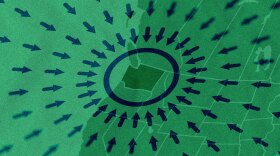Some of the first images of space captured by the Vera C. Rubin Observatory in Chile were released earlier this week.
In Seattle, researchers and students at the University of Washington gathered to view the photos at the campus' planetarium on Monday. The university has played a big part in the development of the powerful telescope.
A crowd of about 50 people looked up at the red clouds of gas and dust of a far off nebula while they listened to a presentation on the observatory.
John Parejko was excited to finally see the images. Up until recently, he was one of the UW scientists working to get the observatory up and running.
“I’ve been sort of bouncing around in the planetarium here telling people 'look over there, look over there, look at that,'” he said.
Researchers at UW have worked for years crafting software for the Rubin Observatory, including Meredith Rawls.

Gazing at the images, she said, “It’s awesome. It’s a relief. It works."
The observatory is preparing to begin a survey of the night sky that will span a decade. To do this, scientists and engineers built the largest digital camera in the world.
Pointing at the photo of the nebula, Rawls is impressed by all of the details captured.
“Almost every dot of light is a galaxy with like its own billions of stars in it and like space is just so big and we’re only barely scratching the surface,” she said.
This project is expected to help spur a huge wave of discoveries – like helping scientists better understand dark matter and dark energy. The telescope will produce so much new data that it will be almost too much to comprehend, according to Mario Jurić, the lead investigator on the UW Rubin Observatory team.
“[The] vast majority of the images will never be seen by [the] human eye," he said. "They'll be seen by our software because there's just so, so, so many of them.”
The software and algorithms Jurić's team has worked on will help astronomers decipher the images captured by the telescope.
“That’s this next frontier in astronomy where we really really depend on teaching computers to do things that we used to do ourselves,” he said.
Without the software the UW team created, Jurić said it would be impossible for humans to process all the data created by the Rubin Observatory.







